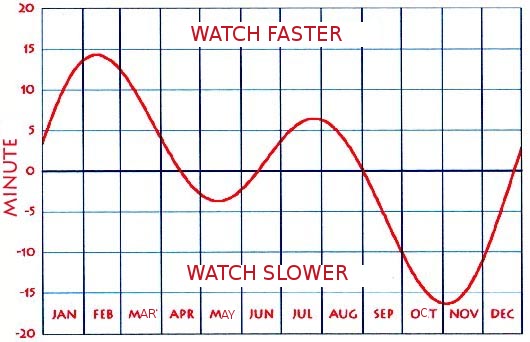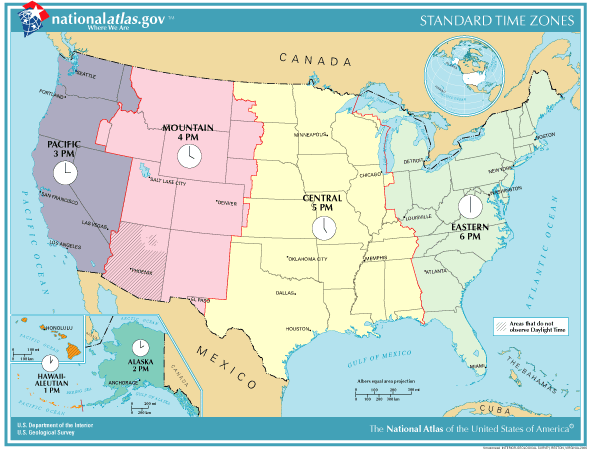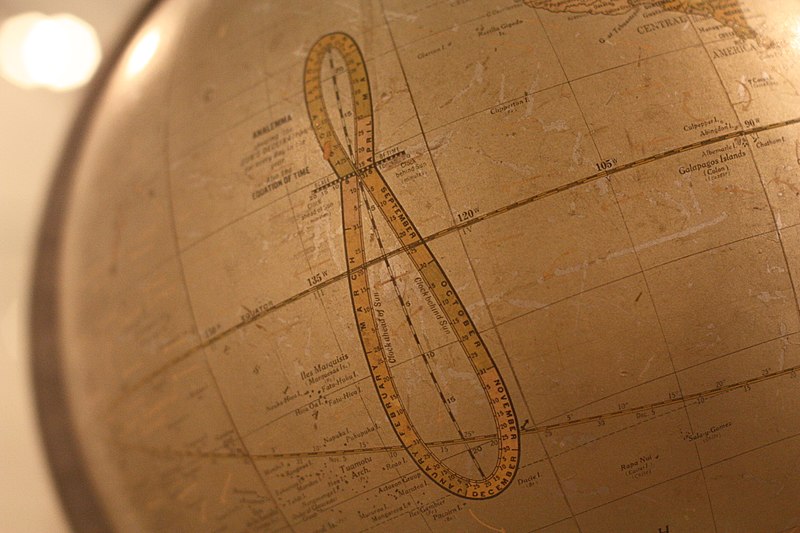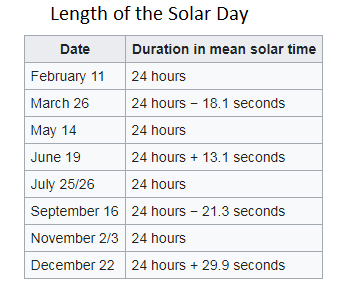
Latest solar noon comes in February
February 11 ushers in the latest solar noon – for all of 2022, and for the entire globe – by the clock. Solar noon is a natural event, not an artificial construct, although our clocks and calendars measure its continual shift throughout the year. Solar noon – aka midday – refers to that passing instant when the sun reaches its highest point for the day, midway between sunrise and sunset.
At solar noon, the sun is said to cross your meridian, as depicted on the diagram below. No matter where you live worldwide, the sun can only be at one of three places in your sky at solar noon: at your zenith (straight overhead), south of zenith, or north of zenith. The noonday sun can only reach zenith at the tropics. From northern temperate latitudes, the noonday sun is always south of zenith. At southern temperate latitudes, the noonday sun is always north of zenith.
The 2022 lunar calendars are here. Order yours before they’re gone!

The equation of time
We invite you to check out the graph below. It shows what’s called the equation of time. That’s a fancy name for the discrepancy between solar noon and clock noon. As the graph shows, the latest solar noon in February occurs a solid 1/2 hour later by the clock than the year’s earliest noon in early November.
Yearly, the latest solar noon happens on (or near) February 11 and earliest solar noon happens on (or near) November 3. That’s true no matter where you live worldwide. North, south, east, west on the globe … doesn’t matter. For all of us, solar noon happens over 30 minutes later by the clock on February 11 than it does on November 3.
Before the advent of time zones and standard time, the equation of time graph (below) applied to anywhere worldwide. In our day and age, the graph refers to places that reside on the center line of a given time zone. For example, Denver, Colorado – at 105 degrees west longitude – sits on the center line of the Mountain Standard Time zone. So, in Denver, solar noon reads 12:14 p.m. by the clock on February 11, and 11:44 a.m. by the clock on November 3.
Elsewhere within a given time zone, the standard clock time for solar noon differs. Keep reading to understand why.

Where are you in your time zone?
Earth is divided into around 24 time zones, and each time zone is (in theory) 15 degrees of longitude wide. Because Earth is a sphere, time zones are widest across at the equator. They reduce in width as you go north or south, until they reach to zero degrees at the poles. In other words, the time zones meet at the poles. So, at the equator, a time zone is (in theory) about 1035 miles (1665 km) wide. By the way, we keep saying “in theory” because time zone borders typically aren’t straight lines. They’re often drawn in a zigzag fashion to accommodate the boundaries of nations, states or provinces.
But for all of us – unless you live at Earth’s North or South Pole – your time zone has some width to it. And you might have noticed that sunrise and sunset in the sky happen later (by the clock) as you go directly west in a given time zone.
So it is for solar noon. Solar noon comes 4 minutes later by the clock for every 1 degree you live west of your time zone’s eastern edge. Solar noon comes 4 minutes earlier by the clock for every 1 degree you live east of your time zone’s western edge. No matter. It’s still the case that – in any year, and at any location – solar noon happens 1/2 hour later by the clock on February 11 than on November 3.
By the way, we emphasize we’re talking about standard time. We are not talking about daylight saving time or summer time, in which we pretend that it’s one hour later than it is.
But there’s no need to go through mental gymnastics to figure out the clock time for solar noon in your location. Simply visit the Sunrise Sunset calendar site, enter your location, and look at the column marked solar noon.
In this way, you’ll know your clock time for solar noon for any day of the year.

Unequal length of solar days
The day – as measured from one solar noon to the next – rarely equals 24 hours. In fact, a 24-hour solar day happens but four times a year, on or near these dates: February 11, May 14, July 26 and November 3. Again, we invite you to study the equation of time graph above. The 24-hour solar days only take place at the turning points above (February 11 and July 26) and below (May 14 and November 3).
The sun and the clock only agree 4 times a year: on or near April 15, June 15, September 1 and December 25. Look at the graph above and you can see that the solar day is shorter than 24 hours on April 15 and September 1, yet longer than 24 hours on June 15 and December 25.

Shorter days at equinoxes, longer days at solstices
Earth-sun geometry dictates seasonal variation in the length of solar days. Solar days are less than 24 hours long for roughly 3 months centered around the equinoxes (March 20 and September 23). And solar days are longer than 24 hours for roughly 3 months centered around the solstices (June 21 and December 21).
Two reasons account for the unequal length of the solar day. First and foremost, the tilt of the Earth’s axis causes the solar day to be more than 24 hours long around the solstices, and less than 24 hours long around the equinoxes. But Earth’s eccentric orbit plays a role, too, either accentuating or lessening the length of the solar day.
Around the December solstice, the Earth is some 3 million miles (5 million km) closer to the sun than on the June solstice. So Earth travels most swiftly in its orbit for the year in December and January. It travels most slowly in June and July.
Hence, at and around the December solstice, the Earth must rotate farthest on its axis for the sun to return to its noontime position. That gives us the year’s longest solar days around the December solstice: 24 hours + 30 seconds.
In contrast, the solar days accompanying the June solstice are considerably shorter: 24 hours + 13 seconds.

Mean sun versus real sun
In short, the mean sun used by the clock is a fiction. The clock presumes Earth’s rotational axis stands upright as we revolve around the sun. The clock also presumes Earth goes around the sun in a perfect circle. Neither presumption is correct. Earth’s rotational axis is titled nearly 23.5 degrees out of perpendicular to its orbital plane. And, as mentioned before, Earth’s distance from the sun varies by about 3 million miles (5 million km).
The mean solar day is 24 hours long. But the real solar day (as measured by the sundial) varies in length throughout the year. The discrepancy between the clock and the sundial is never greater than 1/2 minute on any given day. Even so, the discrepancy accumulates daily for roughly three months. That’s why the latest solar noon in February comes 1/2 hour later by the clock than the earliest solar noon in early November.
Want to know the time difference between the clock and sundial for any day of the year? Go to AstroPixels.com and look under the equation of time column (the fourth column).

Bottom line: February 11 ushers in the latest noontime sun of the year, by nature’s clock. And for folks living at the Earth’s equator, this date also marks the day of the year’s latest sunrise and latest sunset.
The post Year’s latest solar noon happens on February 11 first appeared on EarthSky.
from EarthSky https://ift.tt/YEWbojn

Latest solar noon comes in February
February 11 ushers in the latest solar noon – for all of 2022, and for the entire globe – by the clock. Solar noon is a natural event, not an artificial construct, although our clocks and calendars measure its continual shift throughout the year. Solar noon – aka midday – refers to that passing instant when the sun reaches its highest point for the day, midway between sunrise and sunset.
At solar noon, the sun is said to cross your meridian, as depicted on the diagram below. No matter where you live worldwide, the sun can only be at one of three places in your sky at solar noon: at your zenith (straight overhead), south of zenith, or north of zenith. The noonday sun can only reach zenith at the tropics. From northern temperate latitudes, the noonday sun is always south of zenith. At southern temperate latitudes, the noonday sun is always north of zenith.
The 2022 lunar calendars are here. Order yours before they’re gone!

The equation of time
We invite you to check out the graph below. It shows what’s called the equation of time. That’s a fancy name for the discrepancy between solar noon and clock noon. As the graph shows, the latest solar noon in February occurs a solid 1/2 hour later by the clock than the year’s earliest noon in early November.
Yearly, the latest solar noon happens on (or near) February 11 and earliest solar noon happens on (or near) November 3. That’s true no matter where you live worldwide. North, south, east, west on the globe … doesn’t matter. For all of us, solar noon happens over 30 minutes later by the clock on February 11 than it does on November 3.
Before the advent of time zones and standard time, the equation of time graph (below) applied to anywhere worldwide. In our day and age, the graph refers to places that reside on the center line of a given time zone. For example, Denver, Colorado – at 105 degrees west longitude – sits on the center line of the Mountain Standard Time zone. So, in Denver, solar noon reads 12:14 p.m. by the clock on February 11, and 11:44 a.m. by the clock on November 3.
Elsewhere within a given time zone, the standard clock time for solar noon differs. Keep reading to understand why.

Where are you in your time zone?
Earth is divided into around 24 time zones, and each time zone is (in theory) 15 degrees of longitude wide. Because Earth is a sphere, time zones are widest across at the equator. They reduce in width as you go north or south, until they reach to zero degrees at the poles. In other words, the time zones meet at the poles. So, at the equator, a time zone is (in theory) about 1035 miles (1665 km) wide. By the way, we keep saying “in theory” because time zone borders typically aren’t straight lines. They’re often drawn in a zigzag fashion to accommodate the boundaries of nations, states or provinces.
But for all of us – unless you live at Earth’s North or South Pole – your time zone has some width to it. And you might have noticed that sunrise and sunset in the sky happen later (by the clock) as you go directly west in a given time zone.
So it is for solar noon. Solar noon comes 4 minutes later by the clock for every 1 degree you live west of your time zone’s eastern edge. Solar noon comes 4 minutes earlier by the clock for every 1 degree you live east of your time zone’s western edge. No matter. It’s still the case that – in any year, and at any location – solar noon happens 1/2 hour later by the clock on February 11 than on November 3.
By the way, we emphasize we’re talking about standard time. We are not talking about daylight saving time or summer time, in which we pretend that it’s one hour later than it is.
But there’s no need to go through mental gymnastics to figure out the clock time for solar noon in your location. Simply visit the Sunrise Sunset calendar site, enter your location, and look at the column marked solar noon.
In this way, you’ll know your clock time for solar noon for any day of the year.

Unequal length of solar days
The day – as measured from one solar noon to the next – rarely equals 24 hours. In fact, a 24-hour solar day happens but four times a year, on or near these dates: February 11, May 14, July 26 and November 3. Again, we invite you to study the equation of time graph above. The 24-hour solar days only take place at the turning points above (February 11 and July 26) and below (May 14 and November 3).
The sun and the clock only agree 4 times a year: on or near April 15, June 15, September 1 and December 25. Look at the graph above and you can see that the solar day is shorter than 24 hours on April 15 and September 1, yet longer than 24 hours on June 15 and December 25.

Shorter days at equinoxes, longer days at solstices
Earth-sun geometry dictates seasonal variation in the length of solar days. Solar days are less than 24 hours long for roughly 3 months centered around the equinoxes (March 20 and September 23). And solar days are longer than 24 hours for roughly 3 months centered around the solstices (June 21 and December 21).
Two reasons account for the unequal length of the solar day. First and foremost, the tilt of the Earth’s axis causes the solar day to be more than 24 hours long around the solstices, and less than 24 hours long around the equinoxes. But Earth’s eccentric orbit plays a role, too, either accentuating or lessening the length of the solar day.
Around the December solstice, the Earth is some 3 million miles (5 million km) closer to the sun than on the June solstice. So Earth travels most swiftly in its orbit for the year in December and January. It travels most slowly in June and July.
Hence, at and around the December solstice, the Earth must rotate farthest on its axis for the sun to return to its noontime position. That gives us the year’s longest solar days around the December solstice: 24 hours + 30 seconds.
In contrast, the solar days accompanying the June solstice are considerably shorter: 24 hours + 13 seconds.

Mean sun versus real sun
In short, the mean sun used by the clock is a fiction. The clock presumes Earth’s rotational axis stands upright as we revolve around the sun. The clock also presumes Earth goes around the sun in a perfect circle. Neither presumption is correct. Earth’s rotational axis is titled nearly 23.5 degrees out of perpendicular to its orbital plane. And, as mentioned before, Earth’s distance from the sun varies by about 3 million miles (5 million km).
The mean solar day is 24 hours long. But the real solar day (as measured by the sundial) varies in length throughout the year. The discrepancy between the clock and the sundial is never greater than 1/2 minute on any given day. Even so, the discrepancy accumulates daily for roughly three months. That’s why the latest solar noon in February comes 1/2 hour later by the clock than the earliest solar noon in early November.
Want to know the time difference between the clock and sundial for any day of the year? Go to AstroPixels.com and look under the equation of time column (the fourth column).

Bottom line: February 11 ushers in the latest noontime sun of the year, by nature’s clock. And for folks living at the Earth’s equator, this date also marks the day of the year’s latest sunrise and latest sunset.
The post Year’s latest solar noon happens on February 11 first appeared on EarthSky.
from EarthSky https://ift.tt/YEWbojn

Aucun commentaire:
Enregistrer un commentaire